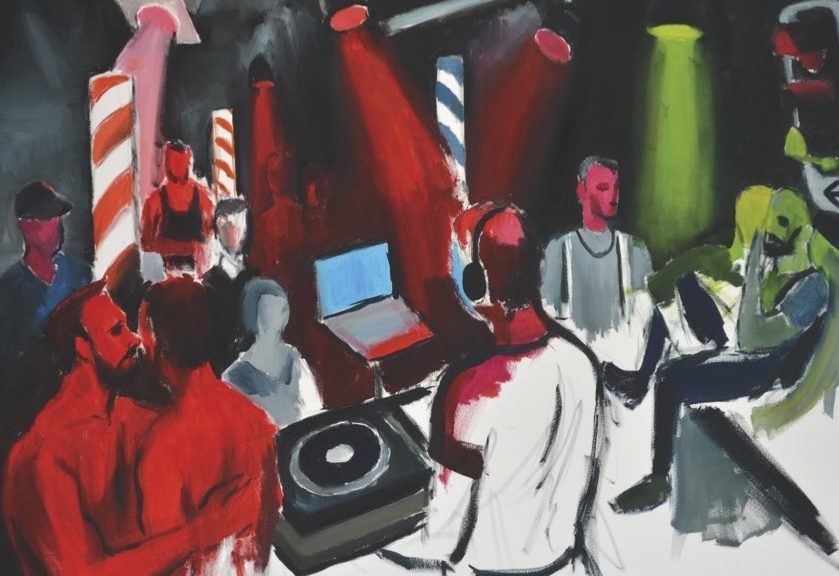… was an exhibition at Objekt klein a, whose works and texts were shown on the dance floors of the Dresden club. The ravers could put the motifs – printed on postcards – in their pockets and take them home later.
Where we will find a continuation of the exhibition that started in 2018-2019 has already been decided: at the boxes on the left. Only when – that is still unclear.
THINGS THAT MAKE A GOOD DANCE FLOOR
A good dance floor is a hard fight. Every moment put together. You reach out water to strangers. Bottles break. The broken glass gets cleaned up. You’re always the first to know the big news. This is the place to make out and to produce its energy ecologically. Tears dripping onto it. And still making us look fabulous. Taking pictures isn’t required. On a good dance floor you receive a lot of all the good stuff. An invitation and a home. A safe space for Homos, Trans*, Queers and for everybody else. Here, everything can happen, but No still stays No. Consensus is enthusiastic. The Dancefloor knows no age and loves all endlessness. It’s spirit lives on diversity, on features, on preferences, origins and on everybody’s physical constitutions, that came. “This Must Be The Place” Everything you need, from pen to paper. On a good dance floor you consume out of pleasure. Things go really wrong. The beginning of great friendships. It’s okay to let go completely. We are right by your side. It’s where we clap. And where awareness is on the top of the list. The air thickened by dust. Those who don’t behave, get a announcement. And those who don’t understand, have to leave. A good dance floor widens our perception. This is the place to give and to get, to be really silly. A good dance floor is as good as those, who are dancing it. It’s at it’s best, if it stays a gap forever.
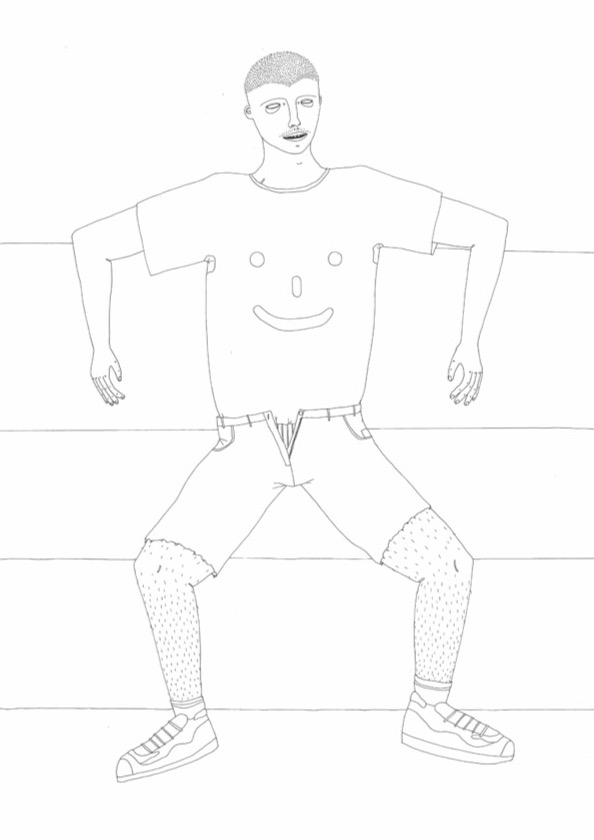
MOVE ANY MOUNTAIN
Can You Feel It? I Can Feel It. In the Heat of the Night. Domina CC RMX. I’ve Lost Control. Only Wanted To Be. Just Not Norma. Good Time. Step By Step. Never Gonna Let You Go ’97. Lack of Love. Three Pills Into A Fist. The Thief That Stole My Sad Days. I Can’t Forget. I Need A Friend. Let Me Show You Love. You’re So Just Just. Let Me Love You for Tonight. I’ll Say A Prayer 4 U. Your Love Will Set You Free. I Write Your Name. What’s Your Number? I’ll House you. What About This Love? The Further You Look The Less You Will See. Boom Boom Boom. Shake Your Body. Supermodel (You Better Work). Just Like A Queen. Is It All Over My Face? Juicy Sushi. Revenge Of The Orange. Low Tension. Body Drill. Sugar is Sweeter. Moment Of My Life. Break 4 Luv. Got To Be Real. Music Sounds Better with You. (I Wanna Give You) Devotion. Pump Up the Volume. Music is the Answer. 7 Ways to Jack. This is Acid. Mommy What’s A Record? What Is House Muzik. Yo Yo Get Funky. Here Is Your Trance Now Dance. The Real Thing (If I Can’t Have You). It’s Up To You. Did You Take My Money? Intoxication. Land of Confusion. House Nation. City Lights. The Sun Can’t Compare. Take Some Time Out. Bring Down the Walls. Soul Revolution. Can You Dig It? Passion (Do You Want it Right Now?). Love Hangover.

ABSOLUTELY, HERE AND NOW
The Sunday sun shines somberly, but warm on the fully occupied couch. The coterie illustrious; the ashtrays brimming. She listens to herself talking and talking. About the times we live in: lost past; lost future. The present, indifferent to itself, hardened to an overpowering block. Changes for the better? Wrong! Acting on this seems impossible and senseless. Political and economic upheavals; the merciless realism of turbo-capitalism, crisis world. The hamster wheel glowing red from performance and consumerism. In all of their exaggeration. Depression and hedonism like two sides of the same coin. Confused liberatory impulses, boredom, rituals, fragmentation. The jaded self… and then she suddenly sees herself amid the people. What she says seems to reach no one. She gets up, stands in the middle of the room and less than five minutes later: outside at the bus stop. Freezing and dressed far too light she presses the Merve book “Absolute Gegenwart,” which is in her coat pocket, against her chest. Borrowed weeks ago and forgot to return the book. She will read in it again today.
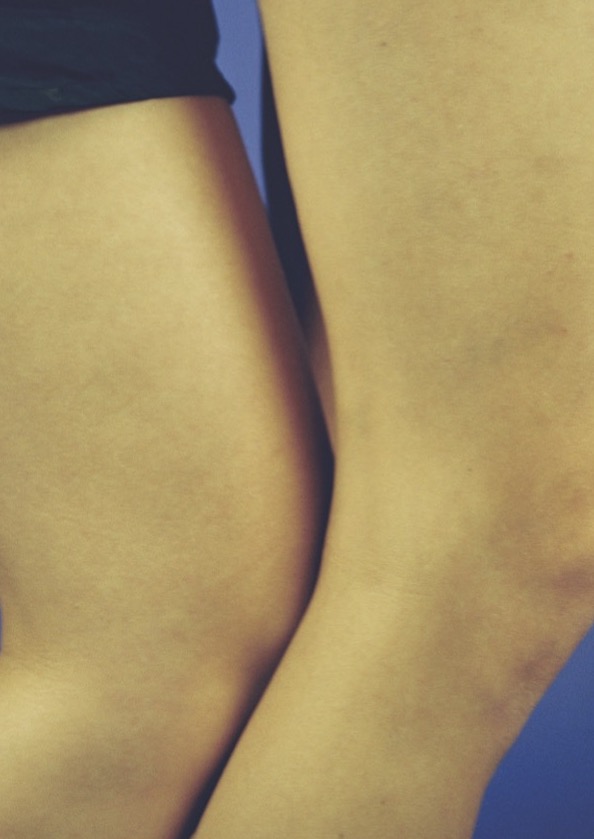
COOL. THANKS. KEEP GOING.
The day before yesterday, 4:29
Where?
At the big bar
Pick me up
Couch upstair
Should I?
Come
I come.
The day before yesterday, 9:54
Well honey what’s up?
Let’s go!
The day before yesterday, 11:39
Where?
The day before yesterday, 14:07
Where are you?
The day before yesterday, 18:20
Where now?
No network
The day before yesterday, 21:21
When are you leaving?
Now
Come. Cloackroom.
Yo
Yesterday, 00:31
Hey, how are you?
Yesterday, 01:00
Be there in 5min
Fun
Come down for a moment?
Yes
Now
I’m standing in line in the cloakroom for you.
Yesterday, 10:25
Groundfloor, at the front.
In front of the dj?
At the bar, corner with the dj booth
At speakers on the left
Come here again, please… small bar
Sent as a SMS
Yesterday, 12:25
Then we take that.
Cool. Thanks. Keep going.
Today, 9:18
Do you have my baseball cap?
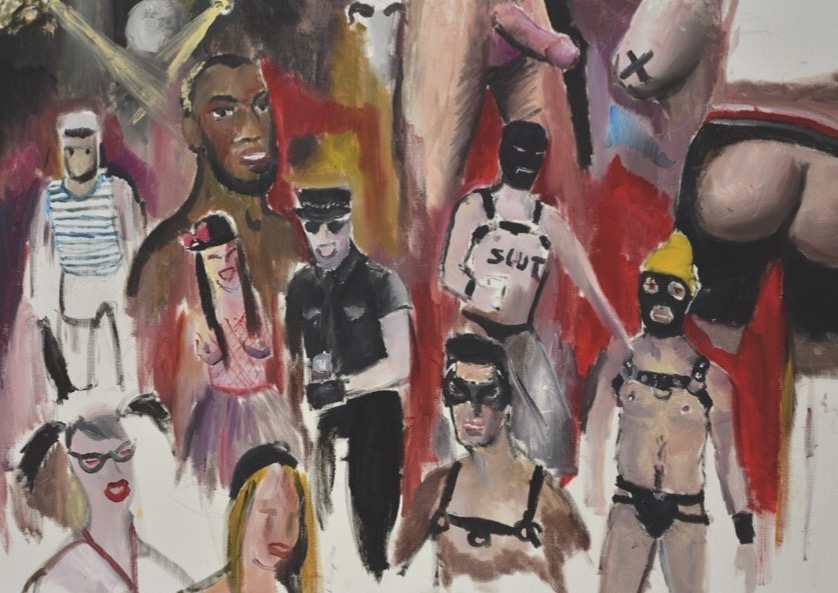
REALLY?
Oh, you wouldn’t believe it, he’s got Gono up his ass, I just wanted to let you know, but then you were—like—already gone, and we’d probably have to get married to please them, his cousin actually calls herself Amanda now, the darkroom behind the urinals is the best place anyways, she went totally nuts there, I don’t wanna trash anyone though—anyways—he said she should just use condoms—well—you wouldn’t believe it, she left with the yoga instructor, they say it’ll never work out, supposedly, then the wig flew off—scream—oh, only gays would be so vicious, I saw him again at the Bona Riah, top or bottom – you couldn’t tell, she really hates me, the old hag, she just doesn’t accept it, like a poodle in the rain, hasn’t spoken a word to me for months now, such a looker, such a knee jerk, and did you know, they are both in interior design now and the Christopher Street Day has to be called Pride Day from now on, his ex probably just got on PrEP, and both of his lovers too, just imagine, they are all still together, oh don’t even get started, she just doesn’t greet me anymore, unbelievable, oh-h-h they really mocked him silly, I could only pick out scraps of words he just passed out in the last club night, I was completely shocked, his roommate’s now tailoring a harness for him, I heard touching is not his thing, but I’m telling you somehow he likes you—like—really, darling.
AT THE THE SPEAKERS ON THE LEFT
TO LOSE ONESELF
in the cosmos of dancing, partying and clubbing. How do we lose ourselves completely without losing ourselves forever and how do we find our way back again? – The exhibition An den Boxen links attempts to investigate these questions.
By partying and dancing, we can and want to try to let go of as much as possible: control, innocence, shyness, inhibitions, the rationality of everyday life, the thread in our chatter – our foothold. Not everything can be handed over at the coatcheck. There are, though, some things we don’t want to lose no matter what: our face, our mobile phone, our balance, depending on the situation: our mind or self-control; and finally: hope! It’s difficult to not lose one’s overview here. Techno holds the immense—yet dangerous—promise of not necessarily having to look for orientation and concrete answers here.
THE EXHIBITION
is a child of Dresden’s club culture. The people behind it are engaged in the fields of visual arts, performance, public health, label/club and other sub-cultural functions.
An den Boxen links is intended to be shown within the spectacle of nightlife, but it still packs a set of motifs: Some of the themes along with all of the texts are presented on six postcards (some in English) and are spread across different parts of the club. It is intended to leave one’s own self-centredness behind in order to approach the questions we ask – with the help of the power of art. The texts—in their disparate forms as sampled remixes, a manifesto or a smartphone chat ping-pong—are supposed to give an impulse to talk about the topics rather than to just passively observe. Questions concerning partying and celebrating are universal. They can and ought to be discussed outside and beyond the context of the chill-out zone, after-hours and the club backstage. For sure, there are often no easy answers to either the one or the other – but maybe that’s a good thing.
OCCUPYING SPACE
for our own way of celebrating life extraordinaire is a precondition for free creative management – the determination of what happens and conversely what doesn’t happen within a space. This “self-determined space” questions the functions assigned to it from and by the outside: We can also understand it as the “freedom assigned to us”. This is where we’re free to step outside of our usual selves, ex-stasis, as long business as usual in terms of school or work, etc., can continue the next day. It’s necessary to break this repressive state over and over. Reflection is a beginning. The potential(s) of emancipated anonymity; heterotopias aiming at transformation and the resistance of the beat that eludes any kind of exploitation are to be explored incessantly.In this sense all participants recreate the moment on the dance floor in a new and active way again and again. The quality of the dancefloor as a gap is its infinite openness and undeterminedness.
THE CONSUMPTION
of both legal and illegal psychoactive substances (and the set for the consumption), its euphoric-intoxicating effects and its influence on our collective party experience are among many other essential aspects in this process of constantly recreating the gap. There are many different ways to deal with challenges and problems. Deficit-fixation (focusing on what’s missing, non-creative criticism, etc.), ideological ideas of “bad” drugs as well as the abstinence-attitude of many related support services are unambiguously counterproductive. On the contrary, concrete measures for harm reduction, such as acceptance-oriented information provided in clubs, the legalisation of all psychoactive substances in addition to their testing (drug checking) and reflection on one’s consumption is far more promising. A fundamental change in attitude towards more acceptance besides a structurally different drug policy are necessary to achieve this goal.
Last but not least, it is necessary for users to organise themselves in order to stand up for their own concerns. The potential for this lies in the club and nightlife scene itself, where user-initiated projects can emerge..
THE ATTITUDE
and manner of dealing with the limits of another person along with their restraintlessness is centered on a fundamental respect for privacy, non-violence (incl. verbal) during conflict and the recognition of the right to equality for all involved. Everyone has the right to decide about her- or himself. This goes far beyond consumption/euphoria and in the end doesn’t only apply on a physical or sexual level. The concept of awareness expresses the need for active consciousness and attentive understanding of all these aspects. Sometimes it requires special safe spaces, precautions or rules, sometimes it doesn’t. In this way we can lose ourselves–together or individually–in the extraordinary world of partying and celebration without getting lost.
Okay, so where do we meet in case we get lost later? Well, up front on the dance floor. At the speakers on the left!
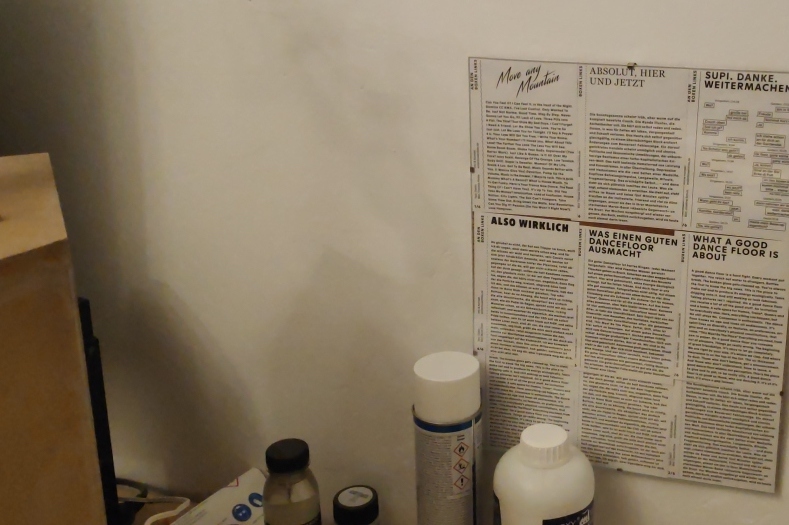
T
Alone outside or inside the midst of the hustle and bustle? – THERESA ROTHE (*1990) works and lives in Dresden. She’s a passionate coffee drinker, belongs to the boulder generation and spends a lot of time outdoors. She studies fine arts (sculpture class) at the HfbK and works at the Stephanie Kelly Gallery.
Her approach as an artist is interdisciplinary: Costumes collaborate with graphics, installation dancing and her painting can even be a performance. The confrontation with her own body, curiosities of everyday life and the voyeuristic view are the objects of her work.
Her series Today reads like a chronicle of ever-changing daily conditions. They are forms of being. In Today, their essence, the rapid change from one to the other, stands for the moment, the present and thus also for the fleetingness and transience of the now. Each picture deals with a moment, the feeling of the straight-plane. It is an illustration of what cannot be fully expressed through language. She says: “Drawing is meditative spinning. To draw something again means for me to observe carefully what still seems important to me when I look at it again”.
M
House or Techno – MURAT ÖNEN (*1993), who grew up in Istanbul/Turkey, is currently a master student at the HfBK and has recently moved to Leipzig. His works often consist of collage-like, composed scenes that directly refer to (gay) nightlife: Locker rooms, toilets, fetish outfits and, of course, guys.
His Live Party Paintings (2015 – 2016) emerged in conjunction with the Pornceptual Parties in Berlin and the gay-queer underground format Hot Club in Zurich and it initially focused on the ban on taking pictures, which often (understandably) exists at parties. Murat himself was once kicked out of a big techno club because he accidentally photographed the club floor. That made him decide to go to the party with his easel. “Painting amidst the dancers was then a real show. It was also intended as such. The difficult conditions, the flashing and especially colorful disco light – I couldn’t see my colors at all! – The spatial narrowness and the strong reactions of the guests, all this put the process of painting and myself in the center of the event. That was new.”The pictorial element of the masks refers to a subcultural fetish aesthetic and certain role conceptions, which are strongly related to dominance and submission. In the interplay of anonymization, visibility and invisibility, they also symbolize the paradox of the simultaneity of being outed and not outed. In this sense, the masks can also be understood as an expression of an alternative queer survival strategy beyond the Closets, the simple logic of hiding.
A
Go home? Or stay a little longer? – ALBRECHT WASSERSLEBEN (*1984) is DJ, Best Boy at the gorgeous house label Uncanny Valley and otherwise works in a film agency. He considers the charming small-town character of Dresden to be the city’s biggest disadvantage: its remoteness from the larger contexts, thoughts and zeitgeist of the world. This also applies to awareness and sensitivity with regard to gender in a club context. “Freedom in the decision about one’s own sexual identity means responsibility and the elimination of structures of order. This can be tried out in the fields of visual arts, music and also with this exhibition. But all this is not possible without questioning one’s own role as a type and learning from one’s own mistakes.Not least in order to promote diversity in our scenes more, Albrecht is currently organizing the Dresden party series XXY. And without his keeping at it, At the boxes on the left would never have left the status of a fixed idea.
J
Day or night? – JOSEFINE SCHULZ (*1993) reads Just Kids by Patti Smith, cultivates a great enthusiasm for interiors and animals and the seemingly intimate relationship of people to them. She is studying free art at the HfbK and is currently involved in the Stephanie Kelly Gallery. Coming from painting, the gallery increasingly became an acting figure for her work. Wall as canvas, an attempt to appropriate the space in order to take a closer look at the social references in it and also the loneliness.
The working title Closer of her series of photographs refers to touches, gestures, bodies and their vulnerability. Being close without being really close – the naked fear of real closeness.So she says: “In the club I see moments when everything around me becomes blurred. Those present are physically super close and yet remain anonymous. Often we miss the now.” Closer was born out of an intuitive caution and the desire to work with people. Photographing the subjects in parallel, both analog and digital, was possibly an attempt to lose oneself photographically without completely abandoning the necessary balance between closeness and distance.
F
Are static charges the opposite of flexible routines? DIASHI (*1972), who grew up on the Baltic Sea, lived in Leipzig for a long time and helped to build up the queer collective Homo Elektrik (“Dancing is the warmest jacket”). He worked for the Drug Scouts, a drug information project with an accepting approach. Today he is an activist of the Love Lazers group. Their information flyers on New Safer Sex are aimed primarily at men who have sex with men and need condoms as well as other ways to protect themselves against HIV: “PrEP is the revolution here, but many people don’t know anything about PEP or Treatment as Prevention. This has to change!Since Diashi has been living in Berlin, he has been working in the ://about blank as “responsible for Friendship and Atmo”. Together with a friend he runs the techno house label Mikrodisko, which recently produced a tape for crowdfunding the Object klein a. Diashi is currently in Tokyo to develop a Mikrodisko onigiri.
R
Rice or pasta? – Whatever, it’ll be fine. ROGER LEHNER (*1989) grew up in Switzerland and now lives as a graphic designer in Dresden. When he is not climbing or cooking, visual design is his everyday life. In contrast, he often takes a two-dimensional approach to design, his graphics are created from the content. Fonts bring this out particularly well: “I like fonts, just like design, as straightforward and conceptual as possible, without a lot of frills. His own typo favorite is the Pylon font, which he created together with a graphic designer buddy from Berlin for an art space. The special thing about it is that it is only drawn for the vertical direction when the letters are on top of each other (like hotel lettering on the corners of houses), but it doesn’t work if you set it horizontally.
© Love Lazers 2021. Published with permission of the artists. The copyright for images and text belongs to the artists and authors. Photos: Josefine Schulz, illustrations: Theresa Rothe, oil on canvas: Murat Önen, texts: Diashi, layout: Roger Lehner, idea and production: Albrecht Wassersleben, in coop with Objekt klein a in Dresden, December 2017.
